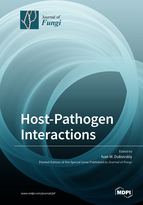Host-Pathogen Interactions: Insects vs Fungi
A special issue of Journal of Fungi (ISSN 2309-608X).
Deadline for manuscript submissions: closed (31 August 2020) | Viewed by 39071
Special Issue Editor
Interests: insect immunity; entomopathogenic fungi; detoxification and antioxidant systems; fungal virulence factors; coevolution of host–parasite systems; microevolution of insect defense reactions; melanization; redox balance
Special Issues, Collections and Topics in MDPI journals
Special Issue Information
Dear Colleagues,
Although many insects successfully live in dangerous environments exposed to diverse communities of microbes, they are often exploited and killed by specialist pathogens. In the process of co-evolution of insects and entomopathogenic microorganisms, they develop various adaptive systems that determine the sustainable existence of dynamic host–parasite interactions at both the organismic and population levels. The host defences are designed to exclude the pathogen or mitigate the damage inflicted, while the pathogen counters with immune evasion and utilization of host resources. Entomopathogenic fungi neutralize their immediate surroundings on the insect integument and benefit from the physiochemical properties of the cuticle and its compounds that exclude competing microbes. They interplay host defence with factors which regulate adhesion to the cuticle, cuticle degradation, and stress management. Aspects concerning insects’ immune, detoxification, and antioxidant systems which work synergistically to combat infections and mitigate stress are also of interest. Some proteins demonstrate multifunctional properties, participating in metabolism, homeostasis, and pathogen recognition. This volume will also include studies of host–pathogen interactions with informative approaches (RNAseq, proteomics, RNAi, etc.) that provide valuable insights into the dynamics of the highly aggressive co-evolutionary arms race between entomopathogenic fungi and their arthropod hosts.
Dr. Ivan M. Dubovskiy
Guest Editor
Manuscript Submission Information
Manuscripts should be submitted online at www.mdpi.com by registering and logging in to this website. Once you are registered, click here to go to the submission form. Manuscripts can be submitted until the deadline. All submissions that pass pre-check are peer-reviewed. Accepted papers will be published continuously in the journal (as soon as accepted) and will be listed together on the special issue website. Research articles, review articles as well as short communications are invited. For planned papers, a title and short abstract (about 100 words) can be sent to the Editorial Office for announcement on this website.
Submitted manuscripts should not have been published previously, nor be under consideration for publication elsewhere (except conference proceedings papers). All manuscripts are thoroughly refereed through a single-blind peer-review process. A guide for authors and other relevant information for submission of manuscripts is available on the Instructions for Authors page. Journal of Fungi is an international peer-reviewed open access monthly journal published by MDPI.
Please visit the Instructions for Authors page before submitting a manuscript. The Article Processing Charge (APC) for publication in this open access journal is 2600 CHF (Swiss Francs). Submitted papers should be well formatted and use good English. Authors may use MDPI's English editing service prior to publication or during author revisions.
Keywords
- entomopathogenic fungi
- fungus–cuticle dynamics
- Metarhizium
- innate immunity
- fungal virulence
- pest management







